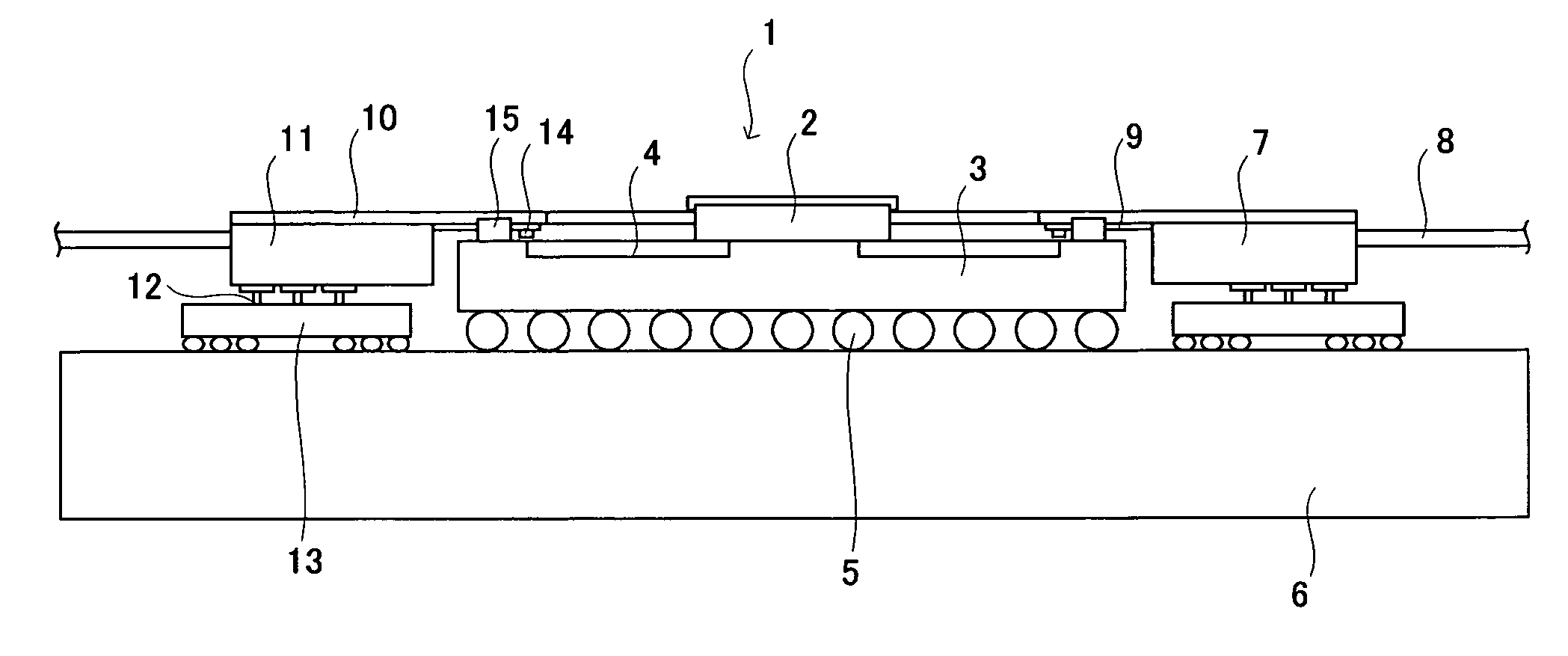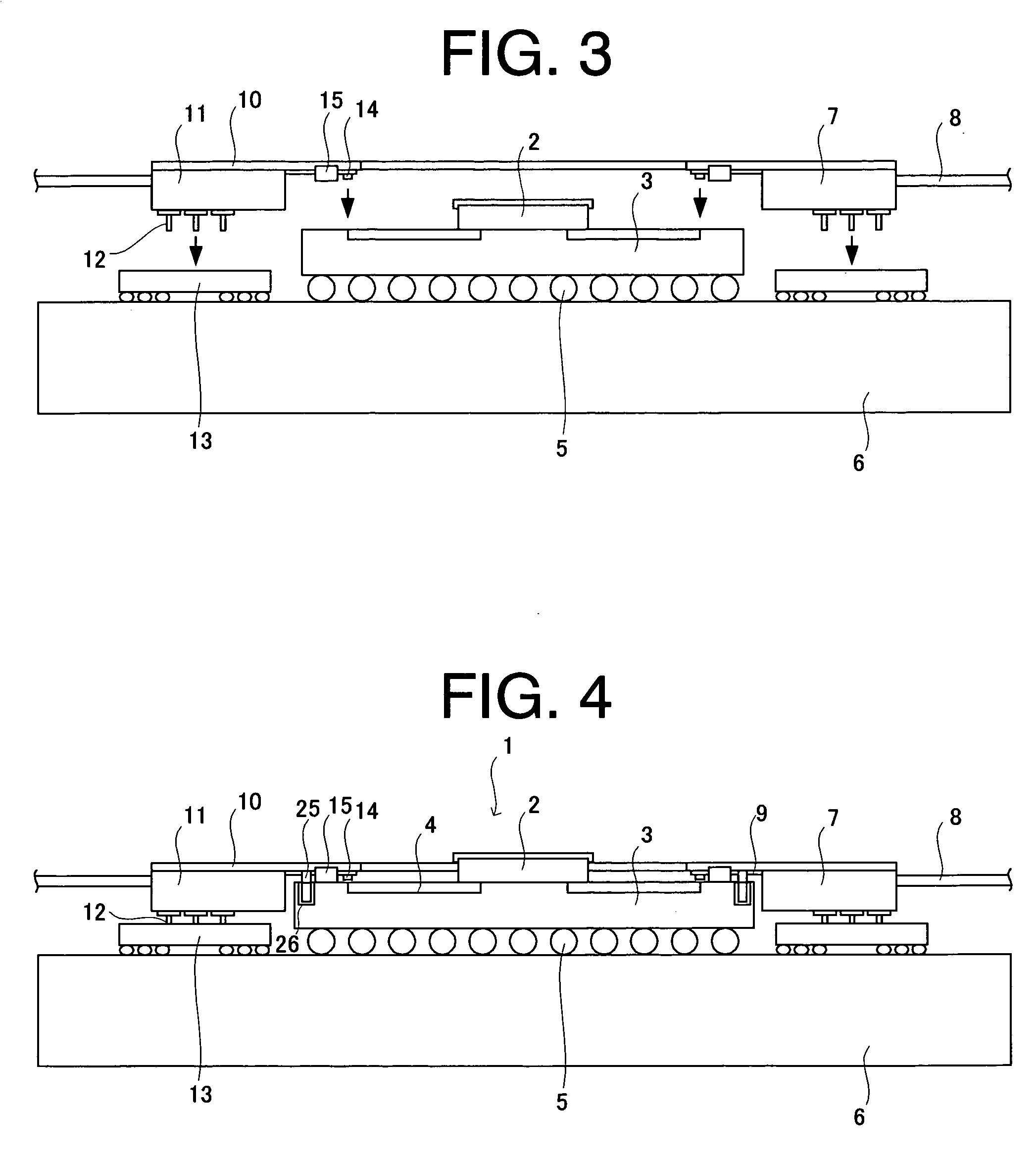LSI package with interface module, transmission line package, and ribbon optical transmission line
a technology of interface module and transmission line, which is applied in the direction of high frequency circuit adaptation, sustainable manufacturing/processing, instruments, etc., can solve the problems of limiting the number of terminals, bottlenecking the performance of personal computers, and moderate improvement of the throughput of the interface between lsis
- Summary
- Abstract
- Description
- Claims
- Application Information
AI Technical Summary
Problems solved by technology
Method used
Image
Examples
first embodiment
[0060]FIG. 1 is a view showing a schematic structure of an LSI package with an interface module according to a first embodiment of the present invention, FIG. 2A and FIG. 2B are enlarged views of a connection portion of a high-speed signal wire according to the first embodiment of the present invention, FIG. 3 is a view showing a mounting process of the LSI package with the interface module according to the first embodiment of the present invention, and FIG. 4 is a view showing a schematic structure of another LSI package with an interface module according to the first embodiment of the present invention.
[0061] In FIG. 1, numeral 1 denotes an LSI package with an interface module, and the LSI package with the interface module 1 includes a signal processing LSI 2. The signal processing LSI 2 is mounted on an interposer 3, and the signal processing LSI 2 and the interposer 3 are electrically connected.
[0062] A high-speed signal wire 4 is wired in the interposer 3, and the high-speed ...
second embodiment
[0072]FIG. 5 is a view showing a schematic structure of an LSI package with an interface module according to a second embodiment of the present invention, FIG. 6 is a view showing a connecting process of an optical interface module according to the second embodiment of the present invention, and FIG. 7 shows a top view of an interposer with an FPC according to the second embodiment of the present invention. Incidentally, the same portions as shown in FIG. 1 are denoted by the same numerals and symbols, so that the detailed description thereof will be omitted.
[0073] As shown in FIG. 5, an FPC connector 31 (an electrical connector) is mounted on the interposer 3, and an FPC connector 32 (an electrical connector) is mounted on the optical interface module 7. Both ends of the FPC 9 are connected to the FPC connectors 31 and 32, respectively, and electrically connected to an electrical connection terminal (not shown) of the interposer 3 and an electrical connection terminal (not shown) ...
third embodiment
[0078]FIG. 8 is a view showing a schematic structure of an LSI package with an interface module according to a third embodiment of the present invention, FIG. 9 is an enlarged view of a connection portion of a high-speed signal wire according to the third embodiment of the present invention, and FIG. 10 is a view showing a connecting process of an optical interface module according to the third embodiment of the present invention. Incidentally, the same portions as shown in FIG. 1 are denoted by the same numerals and symbols, so that the detailed description thereof will be omitted.
[0079] As shown in FIG. 8, in this embodiment, the interposer 3 is connected to a socket 42, which is connected to the mounting board 6 by solder bumps 41, by input / output pins 43 (a socket connection terminal pin). More specifically, jacks 44 fittable with the input / output pins 43 are formed in the socket 42, and by fitting the input / output pins 43 into the jacks 42, the interposer 3 is connected to the...
PUM
 Login to View More
Login to View More Abstract
Description
Claims
Application Information
 Login to View More
Login to View More - R&D
- Intellectual Property
- Life Sciences
- Materials
- Tech Scout
- Unparalleled Data Quality
- Higher Quality Content
- 60% Fewer Hallucinations
Browse by: Latest US Patents, China's latest patents, Technical Efficacy Thesaurus, Application Domain, Technology Topic, Popular Technical Reports.
© 2025 PatSnap. All rights reserved.Legal|Privacy policy|Modern Slavery Act Transparency Statement|Sitemap|About US| Contact US: help@patsnap.com



